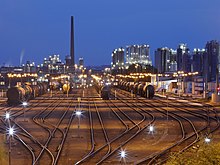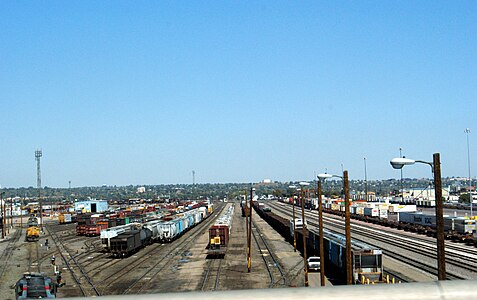| This article includes a list of references, related reading, or external links, but its sources remain unclear because it lacks inline citations. Please help improve this article by introducing more precise citations. (April 2022) (Learn how and when to remove this message) |

A classification yard (American English, as well as the Canadian National Railway), marshalling yard (British, Hong Kong, Indian, and Australian English, and the former Canadian Pacific Railway) or shunting yard (Central Europe) is a railway yard used to accumulate railway cars on one of several tracks. First, a group of cars is taken to a track, sometimes called a lead or a drill. From there, the cars are sent through a series of switches called a ladder onto the classification tracks. Some larger yards may put the lead on an artificially built hill called a hump to use the force of gravity to propel the cars through the ladder.
Freight trains that consist of unrelated cars must be made into a train grouped according to their destinations; this shunting is done at the starting point. Some trains drop and pick up cars along their route in classification yards or at industrial sidings. In contrast is a unit train that carries, for example, automobiles from the plant to a port, or coal from a mine to the power plant.
Flat
Flat yards are constructed on ground too flat to allow a free-fall operation. After a push by a locomotive, freight cars coast to their desired location.
Gravity
Gravity yards were invented in the 19th century, saving shunting engines and instead letting the cars roll by gravity was seen as a major benefit, whereas the larger amount of manual work required to stop the rolling cars in the classification tracks was judged to be not that important. Gravity yards were a historical step in the development of classification yards. They were later judged as inferior to hump yards because it became clear that shunting engines were needed anyway (at least in inclement weather like strong winds or icy temperatures when the oil in the bearings became thick) and because manual labor was getting relatively more and more expensive. Thus, only a few gravity yards were ever built, sometimes requiring massive earthwork (one example is the first German gravity yard at Dresden). The historic technique of a gravity yard is today partly presented in Chemnitz-Hilbersdorf gravity yard (museum).
Most gravity yards were built in Germany (especially in the kingdom of Saxony) and Great Britain (so Edgehill, 1873), a few also in some other European countries, for example Łazy yard near Zawiercie on the Warsaw–Vienna Railway (in Poland). In the US, there were very few old gravity yards; one of the few gravity yards in operation today is CSX's Readville Yard south of Boston, Massachusetts.
Hump

Hump yards are the largest and most effective classification yards, with the largest shunting capacity, often several thousand cars a day. They work similarly to gravity yards, but the falling gradient is limited to a small part of the yard, namely the hump. It is the heart of the yard—a lead track on a small hill over which an engine pushes the cars. Single cars, or a block of coupled cars, are uncoupled at or just before the crest of the hump and roll by gravity onto their destination tracks in the area of the yard where the cars are sorted, called the classification bowl. The first hump in Germany (Leipzig) was built in 1858 and in France (Saint-Etienne) in 1863.

The speed of the cars rolling down from the hump into the classification bowl must be regulated according to whether they are full or empty, heavy or light freight, varying number of axles, whether there are few or many cars on the classification tracks, and varying weather conditions, including temperature, wind speed, and direction. In regards to speed regulation, there are two types of hump yards—with or without mechanization by retarders. In the old non-retarder yards, braking was usually done in Europe by railroaders who laid skates onto the tracks. The skate or wheel chock was manually (or, in rare cases, mechanically) placed on one or both of the rails so that the treadles or rims of the wheel or wheels caused frictional retardation and resulted in the halting of the railway car. In the United States, riders in cars did this braking. In modern retarder yards, this work is done by mechanized "rail brakes," called retarders, which brake cars by gripping their wheels. They are operated either pneumatically or hydraulically. Pneumatic systems are prevalent in the United States, France, Belgium, Russia and China, while hydraulic systems are used in Germany, Italy and the Netherlands.
Classification bowls in Europe typically consist of 20 to 40 tracks, divided into several fans or balloons of tracks, usually with eight classification tracks following a retarder in each one, often 32 tracks altogether. In the United States, many classification bowls have more than 40 tracks, frequently divided into six to ten classification tracks in each balloon loop.

Bailey Yard in North Platte, Nebraska, United States, the world's largest classification yard, is a hump yard. Other large American hump yards include Argentine Yard in Kansas City, Kansas, Robert Young Yard in Elkhart, Indiana, Clearing Yard in Chicago, Illinois, Englewood Yard in Houston, Texas, and Waycross Rice Yard in Waycross, Georgia. Notably, in Europe, Russia, and China, all major classification yards are hump yards. Europe's largest hump yard is that of Maschen near Hamburg, Germany; it is only slightly smaller than Bailey Yard. The second largest is in the port of Antwerp, Belgium. Most hump yards are single yards with one classification bowl, but some, mostly very large, hump yards have two of them, one for each direction, and thus are double yards, such as the Maschen, Antwerp, Clearing, and Bailey yards.
Almost all gravity yards have been retrofitted with humps and are worked as hump yards. Examples include Chemnitz Hilbersdorf (today Saxon Railway Museum), Dresden Friedrichstadt and Nürnberg (Nuremberg) Rbf (Rbf: Rangierbahnhof, "classification yard"), in Germany.
Unique locomotives

| This section may need to be rewritten to comply with Misplaced Pages's quality standards. You can help. The talk page may contain suggestions. (October 2024) |
Hump yards sometimes require unique locomotives; for example, there can be a risk of grounding with larger frames. For this and other reasons, one can sometimes find locomotives specifically made or converted to work a hump yard. For example, the British Rail Class 13 was converted from a pair of British Rail Class 08 to provide more power than one could get with a single Class 08. The class 13s were built because of the risk of grounding with larger locos like the British Rail Class 20. Special locomotives for hump yards in the US were for example the EMD TR family (EMD TR, EMD TR1, EMD TR2, EMD TR3, EMD TR4, EMD TR5 and EMD TR6). These are often referred to as master and slave in GB and cow–calf in the US.
Image gallery
-
 A switcher locomotive pushing a car over the hump at Kornwestheim yard
A switcher locomotive pushing a car over the hump at Kornwestheim yard
-
 Mannheim Rangierbahnhof, Germany, two-sided nearly symmetrical systems for opposing directions
Mannheim Rangierbahnhof, Germany, two-sided nearly symmetrical systems for opposing directions
-
 North Yard in Denver, Colorado, a typical U.S. classification yard in 2009
North Yard in Denver, Colorado, a typical U.S. classification yard in 2009
-
 Chicago and North Western Railway's Proviso Yard in Chicago, Illinois, December 1942
Chicago and North Western Railway's Proviso Yard in Chicago, Illinois, December 1942
-
 Nanxiang Classification Yard in Shanghai, China
Nanxiang Classification Yard in Shanghai, China
See also
References
- James T. Kneafsey (1975). "Major Problems of Railroad Service". Transportation Economic Analysis. Lexington Books. p. 138. ISBN 0669932116.
- Denkmalpflege in Sachsen, Jahrbuch 2019, Sandsteinverlag, Dresden, 2020.
- Köpcke, Mitteilungen (1890). aus dem Bereich des englischen Eisenbahnwesens. Leipzig: Der Civilingenieur.
- "ABC's of Railroading: Terms of the Trade". Trains. Waukesha, Wisconsin: Kalmbach Publishing. June 1991. p. 22. ISSN 0041-0934.
- Rangierdienst A-Z. Berlin: VEB Transpress-Verlag. 1986.
- Bickerdyke, Paul, ed. (October 2015). "Class 13 Tinsley Shunters". Rail Express. No. 233. Horncastle: Mortons Media Publishing. p. 25. ISSN 1362-234X.
- Solomon, Brian; Blaszak, Michael; Gruber, John; Guss, Chris (2014-10-14). Chicago: America's Railroad Capital: The Illustrated History, 1836 to Today. Voyageur Press. p. 37. ISBN 978-0-7603-4603-7.
- Foster, Gerald L. (1996). A Field Guide to Trains of North America. Houghton Mifflin Harcourt. p. 10. ISBN 978-0-395-70112-6.
- Smith, Keith (1999). Supplement to the West Somerset Railway Stockbook (5th ed.). Bishops Lydeard: West Somerset Railway Association. p. 9.
- Industrial Locomotives (6EL ed.). Industrial Railway Society. 1982. p. 232. ISBN 0-901096-44-X.
Further reading
- International Railway Journal (IRJ), New York. Special editions about hump yards in various countries: issues II/66, II/70, VI/75, II/80.
- Armstrong, John H. (1998). The Railroad: What It Is, What It Does (4th ed.). Omaha, Nebraska: Simmons-Boardman. ISBN 978-0-911382-04-4.
- Rhodes, Michael: The Illustrated History of British Marshalling Yards. Sparkford: Haynes Oxford Publishing & Co, 1988. ISBN 0-86093-367-9. Out of print.
- Kraft, Edwin: The Yard: Railroading's Hidden Half. In: Trains (vol. 62) 2002. Part I: VI/02, pp. 46–67; Part II: VII/02, pp. 36–47. ISSN 0041-0934.
- Wegner, Robert: Classification yards. Map of the Month. In: Trains IV/2003, pp. 42–43.
- Rhodes, Michael: North American Railyards. St. Paul (US): Motorbooks International (MBI Publishing Company) 2003. ISBN 0-7603-1578-7.
External links
| Rail infrastructure | |
|---|---|
| Tracks (history) | |
| Trackwork | |
| Signalling and safety | |
| Structures | |
| Types | |
| Railway track layouts | |
|---|---|
| Railway track | |
| Rail sidings | |
| Junctions | |
| Stations | |
| Hillclimbing | |
| Track geometry | |